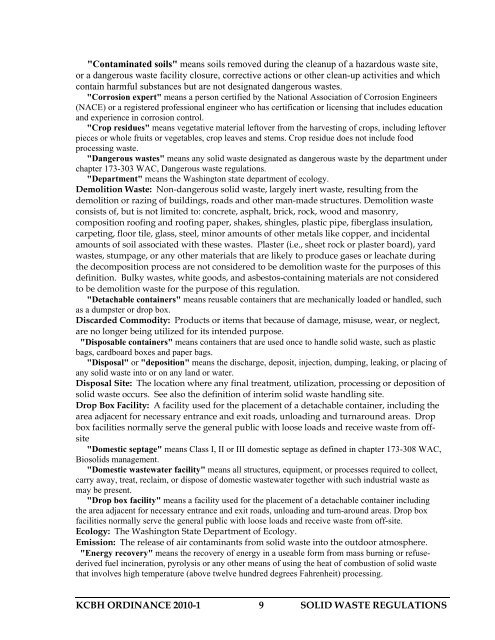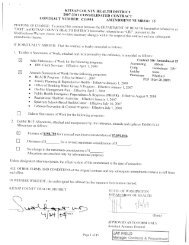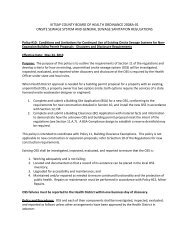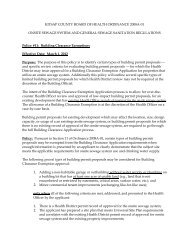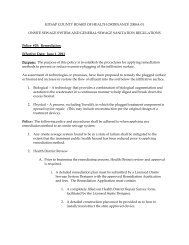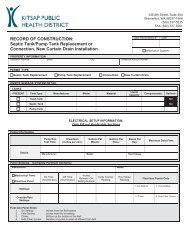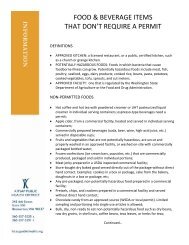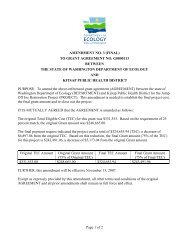SOLID WASTE REGULATIONS - Kitsap Public Health District
SOLID WASTE REGULATIONS - Kitsap Public Health District
SOLID WASTE REGULATIONS - Kitsap Public Health District
Create successful ePaper yourself
Turn your PDF publications into a flip-book with our unique Google optimized e-Paper software.
"Contaminated soils" means soils removed during the cleanup of a hazardous waste site,<br />
or a dangerous waste facility closure, corrective actions or other clean-up activities and which<br />
contain harmful substances but are not designated dangerous wastes.<br />
"Corrosion expert" means a person certified by the National Association of Corrosion Engineers<br />
(NACE) or a registered professional engineer who has certification or licensing that includes education<br />
and experience in corrosion control.<br />
"Crop residues" means vegetative material leftover from the harvesting of crops, including leftover<br />
pieces or whole fruits or vegetables, crop leaves and stems. Crop residue does not include food<br />
processing waste.<br />
"Dangerous wastes" means any solid waste designated as dangerous waste by the department under<br />
chapter 173-303 WAC, Dangerous waste regulations.<br />
"Department" means the Washington state department of ecology.<br />
Demolition Waste: Non-dangerous solid waste, largely inert waste, resulting from the<br />
demolition or razing of buildings, roads and other man-made structures. Demolition waste<br />
consists of, but is not limited to: concrete, asphalt, brick, rock, wood and masonry,<br />
composition roofing and roofing paper, shakes, shingles, plastic pipe, fiberglass insulation,<br />
carpeting, floor tile, glass, steel, minor amounts of other metals like copper, and incidental<br />
amounts of soil associated with these wastes. Plaster (i.e., sheet rock or plaster board), yard<br />
wastes, stumpage, or any other materials that are likely to produce gases or leachate during<br />
the decomposition process are not considered to be demolition waste for the purposes of this<br />
definition. Bulky wastes, white goods, and asbestos-containing materials are not considered<br />
to be demolition waste for the purpose of this regulation.<br />
"Detachable containers" means reusable containers that are mechanically loaded or handled, such<br />
as a dumpster or drop box.<br />
Discarded Commodity: Products or items that because of damage, misuse, wear, or neglect,<br />
are no longer being utilized for its intended purpose.<br />
"Disposable containers" means containers that are used once to handle solid waste, such as plastic<br />
bags, cardboard boxes and paper bags.<br />
"Disposal" or "deposition" means the discharge, deposit, injection, dumping, leaking, or placing of<br />
any solid waste into or on any land or water.<br />
Disposal Site: The location where any final treatment, utilization, processing or deposition of<br />
solid waste occurs. See also the definition of interim solid waste handling site.<br />
Drop Box Facility: A facility used for the placement of a detachable container, including the<br />
area adjacent for necessary entrance and exit roads, unloading and turnaround areas. Drop<br />
box facilities normally serve the general public with loose loads and receive waste from offsite<br />
"Domestic septage" means Class I, II or III domestic septage as defined in chapter 173-308 WAC,<br />
Biosolids management.<br />
"Domestic wastewater facility" means all structures, equipment, or processes required to collect,<br />
carry away, treat, reclaim, or dispose of domestic wastewater together with such industrial waste as<br />
may be present.<br />
"Drop box facility" means a facility used for the placement of a detachable container including<br />
the area adjacent for necessary entrance and exit roads, unloading and turn-around areas. Drop box<br />
facilities normally serve the general public with loose loads and receive waste from off-site.<br />
Ecology: The Washington State Department of Ecology.<br />
Emission: The release of air contaminants from solid waste into the outdoor atmosphere.<br />
"Energy recovery" means the recovery of energy in a useable form from mass burning or refusederived<br />
fuel incineration, pyrolysis or any other means of using the heat of combustion of solid waste<br />
that involves high temperature (above twelve hundred degrees Fahrenheit) processing.<br />
KCBH ORDINANCE 2010-1 9 <strong>SOLID</strong> <strong>WASTE</strong> <strong>REGULATIONS</strong>


